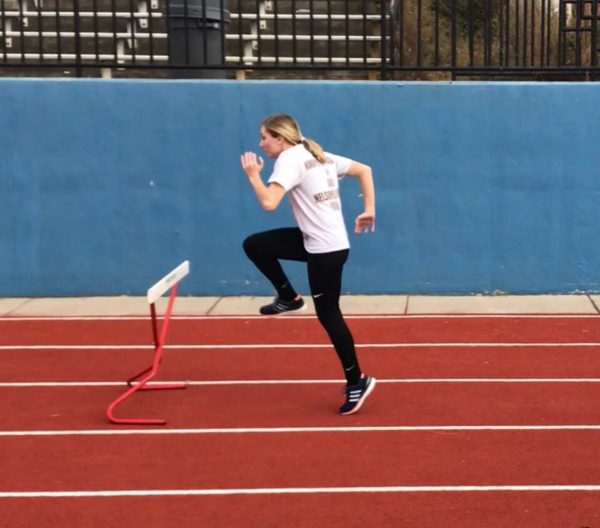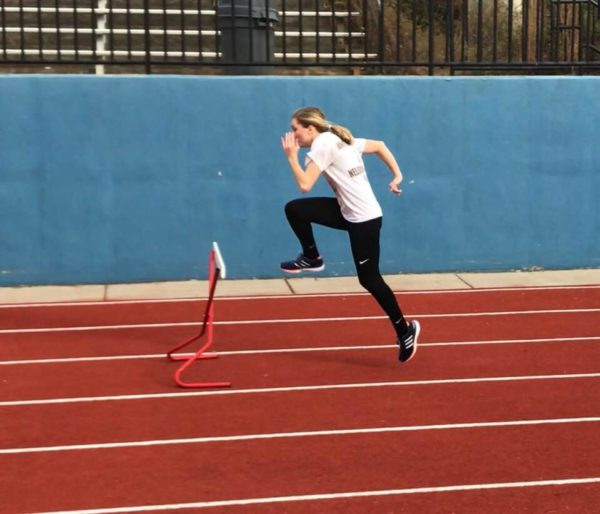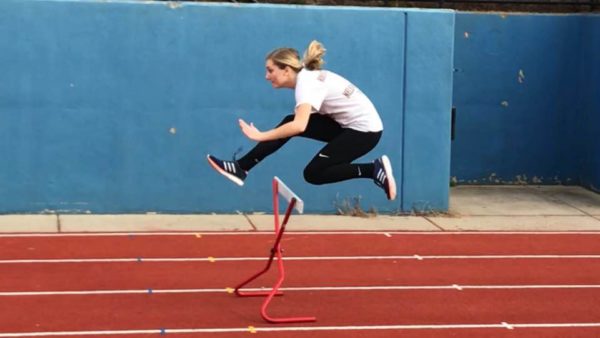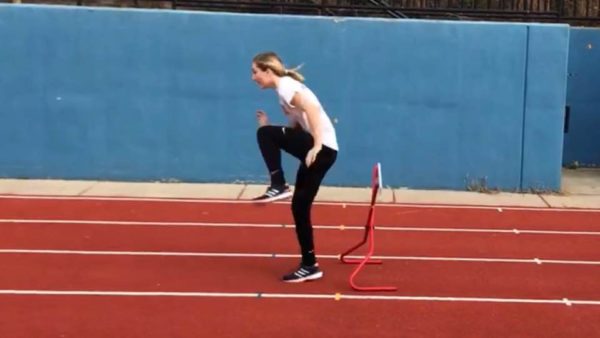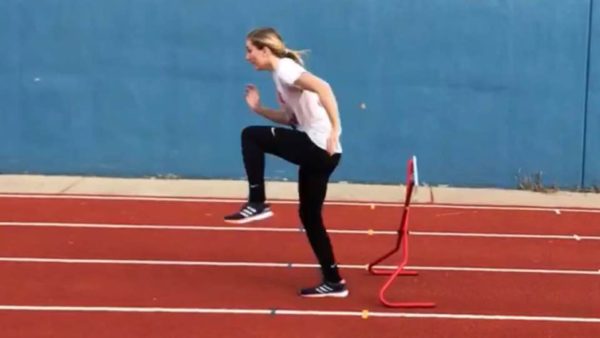Body Positioning into and off the Hurdle
by Steve McGill
Before the days of YouTube and long before the modern days of recording every rep of every training session on a smart phone, coaches and athletes alike relied heavily on still photos to gain insight on technical strengths and weaknesses in the hurdles. Nowadays, as much as I value video recordings of reps and the ability to evaluate them on the spot during practice, I still like the advantages of still photos to freeze time. When playing back video footage on my iPhone, I’ll often find myself slowing things down and rewinding, and then taking screen shots of specific moments in the sprint action or hurdling motion. I did some of that with a couple of my athletes from workout sessions two weeks ago (we didn’t train this past weekend due to some snowfall). In this article, I want to look at some of those screen shots and take you through what I see from take-off to touchdown. This month I will focus on a high school girl, Madi, doing a jammed quick-step drill. Madi, from Ohio, comes down to North Carolina on occasion to train with me in warmer weather conditions. She’s a 16.2-16.4 hurdler looking to drop down into the 15’s this year, her junior year.
[am4show not_have=’g5;’]
[/am4show][am4guest]
[/am4guest][am4show have=’g5;’]
Okay, here we go:
In the photo above, Madi is taking off into the hurdle. As the back foot pushes off, the knee and the heel of the front leg drive up together. Note the positioning of both: the knee is higher than the crossbar, and in front of the heel. The heel is directly under the hamstring. Notice too that the ankle is dorsi-flexed. This is the position that I refer to as “attack mode.” If the heel were in front of the knee, if the knee were lower than the crossbar, the foot would then swing, creating a pause and various imbalances. With the position Madi is in, she can feel like she is hurdling “downhill,” as I like to put it. When the foot of her lead leg extends, it will extend on a slightly downward angle as opposed to kicking up or straight out. Notice also the position of her arms. Lead arm is bent at the elbow with the hand at eye level, and the trail arm is also bent, just slightly behind the hip. Meanwhile, the eyes are up, looking forward, the chin is up, and the torso is slightly bending forward.
In the above photo, Madi has left the ground. The knee of the lead leg remains higher than the bar, and the heel remains behind the knee, under the hamstring. Again, this is attack position. The trail arm is getting away from her a little bit, but because the elbow remains bent, it won’t cause any balance issues. Her lean from the waist has increased, pushing her torso forward more as the eyes and chin remain up.
In the above photo, Madi is in hurdling position. With our style of hurdling, which emphasizes downward angles and the downhill feeling, hurdles will often look like they’re too high over the hurdle, when in fact they’re actually not. The style enables her to land close to the hurdle she just cleared, with the foot landing under the hip, but without the extraneous effort of “snapping down,” thus putting her in a position to sprint off the hurdle. Here, her lean has increased even further, both ankles remain dorsi-flexed (ensuring that she will land on the ball of the foot), eyes and chin remain up, and her hips are pushing forward. The hips pushing forward (as opposed to rising up at take-off) is hugely important in creating velocity through the hurdle and toward the next one. In terms of dorsi-flexion, the way to tell if it’s being done correctly or not is to look at whether the heel or the toe would be facing you if you were standing behind the hurdler. Here you can tell that the heel would be facing you, which means her ankle is in fact dorsi-flexed.
Upon touchdown, Madi’s hips are still pushing forward and she maintains her forward bend from the waist. If she were to come out of her bend, and stand up off the hurdle, she would lose all the momentum she had gathered when attacking the hurdle. That’s why I always tell my hurdlers, “Hold the lean!” Meanwhile, she lands on the ball of the foot, and the knee of the trail leg is facing the front. Also, the trail leg knee remains high, in position to attack the track with the first full stride off the hurdle. Often, hurdlers will let that trail leg drop as they pull it to the front, causing the first stride off the hurdle to be short and lacking in force. Her arms, meanwhile, remain in sprinting position, as the trail arm is now punching up and moving to the front. Notice, also, how close she landed to the hurdle. That’s what I meant when I said that it only looked like she was clearing the hurdle too high. Because of her body positioning upon landing, her first stride off the hurdle will be a forceful one and she will continue to accelerate, without really “trying” to, on her way to the next barrier.
In the above photo, Madi is now on her way to the next hurdle. Although the heel of her lead leg foot is now touching the ground, that’s okay. What you’re seeing is just the force of the landing. In other words, there is no pressure on the heel, because she didn’t land on the heel. The ball of the foot is still bearing her weight, guaranteeing that her ground contact time will be minimal. Meanwhile, she continues to hold the lean, with the chin up and eyes up. Obviously, she won’t hold this deep of a lean all the way to the next hurdle, but she will tell herself to. It’s impossible not to stand up a bit when landing off the hurdle. But as I instruct my hurdlers, “tell yourself to hold the lean, and then you won’t stand up as much.”
Next month we’ll look at a male hurdler from take-off to touchdown, but instead of the quick-step workout, it’ll be from a block start, where it is much more challenging to hit the desired angles, just because of the simple fact that you’re moving much faster.
[/am4show]
